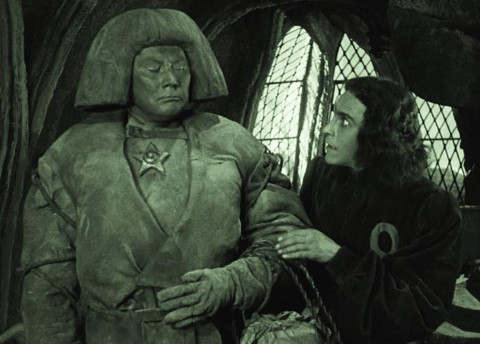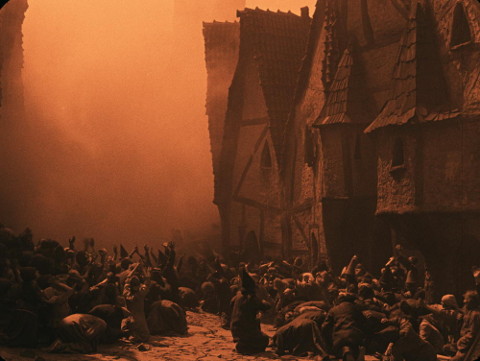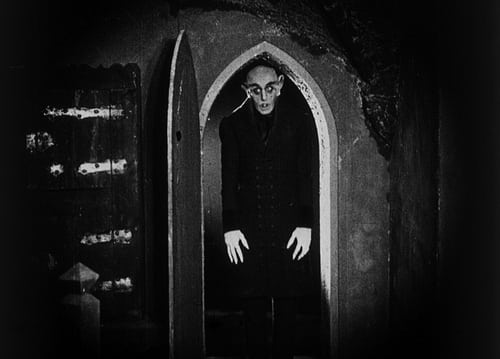Der Golem (1920)
Directed by: Carl Boese, Paul Wegener
Written by: Henrik Galeen, Paul Wegener
Starring: Albert Steinrück, Ernst Deutsch, Lyda Salmonova, Paul Wegener
Germany
AVAILABLE ON BLU-RAY: 18th November, from EUREKA ENTERTAINMENT
RUNNING TIME: 76 mins, 60 mins
REVIEWED BY: Dr Lenera, Official HCF Critic
In the late 16th century, Rabbi Loew, the head of Prague’s Jewish community, reads the stars and predicts disaster for his people. The next day the Holy Roman Emperor Luhois signs a royal decree declaring that the Jews must leave the city by the end of the month. Luhois sends the knight Florian to deliver the decree, but Florian falls in love with Miriam, Loew’s daughter. Despite this, Loew begins to create the Golem, a monster which he will bring to life out of clay to defend his people….
I was hoping that Horror Cult Films would get sent a review copy of Eureka Entertaiment’s Blu-ray release of this classic silent horror movie from Germany. I bought it on DVD a few years ago from another label and watched it, Being duly impressed, I wrote a review, though in the course of doing some research I discovered that the version I had was 16 minutes shorter than the full length version which was also available elsewhere. And, like some other silent movies that were in the public domain so anyone could release it, it also had an irritating music ‘score’ that strung together and repeated bits of classical music without thinking if any of it was appropriate for what was taking place on screen. I never did buy the film in its original form, but thanks for Eureka I was now able to view a fully restored version, and if it seemed impressive before it appeared even more so now. In the silent era, Germany saw an amazing output of strange, compelling and highly artistic horror classics after World War 1, the extremely influential style of these films with their use of things like bizarre sets and forced perspective to give a nightmarish feel becoming known as German Expressionism. The best famous of these pictures are undoubtedly The Cabinet Of Dr Caligari and Nosferatu. The Golem is far less well known now, and it’s a little inferior to those two classics, but it’s a very striking combination of historical drama and horror in its own right that is so visual that it barely even needs the few inter-titles that it has.
Golems have existed throughout Jewish legend, though the most famous one was the Golem of Prague. Co-writer/director Paul Wegener wanted to film the story in 1915 after having it told to him while he was filming Der Student von Prag [The Student Of Prague], but budgetary restrictions meant that he had to set it in the present day, so he thereby turned into a sort of sequel. Despite being a sizeable hit it’s now sadly lost, as is a comedic followup from Wegener called Der Golem und die Tänzerin [The Golem And The Dancing Girl] which may have been the first horror spoof. In 1919, Wegener announced plans for Alraune und der Golem, uniting two folklore characters in one film, Alraune being a demonic female, the result of a forced union between a woman and a Mandrake root. Though posters and other publicity material survive, it was never made. Instead, Wegener set out to make what was basically his prequel [which explains its subtitle] to his 1915 effort, again starring himself as the title creature, and this time armed with a sizeable budget. Ursula Nest was originally intended to play the ‘Little Girl’, but she was too afraid of Wegener in the Golem costume so she was replaced by her older sister Loni for that part and played another child. The film was shot entirely at the Tempelhof Studios in Berlin. It was another success and was remade in 1935 [which also served as a sequel] and 2018. Silent films were sometimes shot simultaneously with the best angles forming the domestic release and the not-so-good angles comprising the export release. However, for some reason the export cut of Der Golem wasn’t used and instead the American distributors took the domestic cut and chopped it down to an hour as well as changing the intertitles. A 1995 restoration used the export cut because the domestic cut could not be found at the time, though it was eventually located in the Belgian film archive in 2017. The 4k restoration wasn’t quite complete though, so had to incorporate bits from the export version. Still with me?
We open with a lovely shot of mountains and a star-filled sky. The mountains don’t look very realistic at all, immediately telling is that this is not at all going to be a realistic tale, and it’s soon followed by plenty of other impressive visual moments like a parade of torches looming bright but not at all illuminating the barely visible silhouettes bearing them. But that’s not to denigrate the plot, which is instantly involving and moves at a decent clip. The Jews of Prague are being persecuted, and throughout the film we’re reminded of the fact that the Jews were horribly treated throughout history and not just by the Nazis; the Holocaust was just the most extreme example, though of course one also cannot help but also see this story as a precursor to one of the most horrible moments in 20th Century history which began to take place only a decade and a half after this film was released. In Prague, the Jews are segregated and live in poverty, and the Emperor wants to drive them out altogether. The Rabbi Loew thinks of a drastic solution. He fashions a man out of clay, but needs to conjure up the demon Astaroth who will tell him the word to bring the Golem to life. He first creates a circle of fire with his wand, then waves a Star of Davis which causes some flaming brands to fly about [pretty convincingly I must say], then out of some some smoke looms a large demonic head looms [the bloody thing almost made me jump the first time I saw this film] with quite creepy goblin-like features. The head spits out smoke which form the letters comprising the word that will bring the Golem to life. I can see all this really terrifying audiences of the time, though occult stuff of this nature was actually seen quite a bit in silent films. We tend to forget this because Hollywood censorship became very tight in 1932 and forbade such hi-jinks from movies unless they were extremely subtle.
The Golem becomes Rabbi Loew’s servant, and the scene where he walks through the city, scares everybody away by his appearance, then wonders into a shop to present the terrified owner a shopping list plays like a comedy sketch today. Then we get a scene that probably inspired the Tower of Babel bit in Metropolis where Loew visits the royal palace and, after presenting the Golem, is asked to show some more magic. He tells everyone that he’s going to show them his ancestors, but nobody must make a sound because if they do, things will go wrong. He conjures up a kind of huge TV screen showing Isrealites walking through the desert. Some ignorant fools in the audience laugh though, so Ahasveras the Wandering Jew does his name proud by actually wandering out of the screen, then the building begins to collapse – but guess who’s around to save the day? However, one of Loew’s countless books tells him that the Golem will turn bad because he will be increasingly possessed by Astaroth, and he does begin to react badly to things, but it’s human plotting that really set him off. Luhois’s messenger Florian and Loew’s daughter Miriam fall in love, even though Florian initially seems rather effeminate the way he prances about and waves about and sniffs the flower he’s holding about while sporting a ridiculously long feather on his hat. But the two are instantly entranced with each other as that darn flower and a very large wine are exchanged in their first meeting, though then in their next scene together when he can’t keep his hand off one of her breasts, they don’t look they’re enjoying themselves much. Even by the style of the period and genre, it’s odd. Later on we see them in bed together, but this love is forbidden. This is not because Lydia Salmonova gives such a strange performance as Miriam with some bizarre emoting, but because it’s between a Christian and a Jew, and eventually Loew’s un-named assistant finds out. Seeing as he rather fancies Miriam himself, he doesn’t tell anybody else about what he’s discovered but instead orders the Golem to kill Florian.
The chain of events that follow seem very old hat but only because they’ve been copied so often since 1920. The final reel involves a fire spreading throughout the city and masses of extras either mostly running in panic or praying in some extremely well staged sequences. However, the Golem may be a little laughable to some modern eyes. He never looks like he’s made out of clay, and Wegener sometimes does a scurry that’s amusing, but also has an ability to make his face look nasty at choice moments, and his eyes are piercing. Wegener has to act with restraint unlike most others around him who perform according to the more mannered style of the time, and often succeeds, like when the Golem is given a flower and sniffs it. You get the sense of this clay creature being fascinated by the beautiful and delicate object. This is echoed in the climax where the Golem encounters a small girl who isn’t frightened by him with a fateful result. This scene clearly influenced the famous similar scene in the 1931 Frankenstein, and one can see a lot of other parallels with that film and indeed story, such as Loew being another Prometheus who creates life with tragic results in what is therefore another cautionary tale saying that we shouldn’t play God, an assistant royally cocking things up for everyone, and the way its monster walks about with huge boots. This creature isn’t evil either, he’s just increasingly controlled by a demon and the final scene touches a little because it shows, for just a minute, a friendly Golem totally free of dark forces again before his death. But why does the Golem grab Miriam and spend much time either carrying her or dragging her [by her hair braids!]. It wasn’t the fashion yet for screen monsters to lust after the heroines, though some versions of the Golem tale do have the Golem falling in love. He remains a strong symbol of how a group of people can achieve power to overcome injustices that are done against them and can turn that power into something that is damaging for themselves – though ironically this Golem is never actually used for the purpose for which he was designed.
In fact at times Der Golem feels like it’s on the verge of being genuinely sophisticated, though some viewers today may find it hard to get a grip onthe rather ‘exotic’ way the Jews are portrayed, particularly their religion which here seems to be a very extreme sect of Judaism like Kabbalah with its black magic, and which seems to back up Luhois’s reason for wanting to drive the Jews away – though the audio commentary tells us that in Jewish folklore some mystics actually did have certain powers that occasionally resulted in creating life. We’re presented with the idea that their religion is a dying one which is being conquered by Christianity, something that’s clearly being shown as a bad thing – well, to me anyway. I wouldn’t be surprised if there aren’t equal numbers of reviewers who claim that the film is either pro-Jew or anti-Jew depending on what they pick up on. For me, it just seems to deliberately exaggerate or simplify many things so that the fable and fantastical qualities of the story can fit in more easily. Of course I don’t want to make Der Golem sound too intellectual, but its story and world have clearly had some intelligent thought put into it. And then of course there are those extraordinary Gothic sets. Prague’s Jewish ghetto, designed by architect Hans Poelzig, much of it looking like it’s been constructed out of clay [which makes sense seeing as the Golem is also made of clay] is a mass of twisted buildings, gnarled stairways, open balconies and doorways, bridges etc appearing at weird angles, creating a really nightmarish world that’s enhanced by Karl Freund’s cinematography which often uses silhouettes and splodges of black to striking effect. Der Golem remains an important picture in the history of the horror film, but I also think that first-time modern viewers will be surprised at how accessible and enjoyable it is.
Rating: 









Der Golem first came out in its fully restored version on Blu-ray in Germany from Universum Film. Eureka have partly replicated that release in terms of presenting the film with three soundtracks along with the export cut. I don’t think I’ve so far seen a silent film that looked as good. Of course there are some lines here and there, but surprisingly few flickers and the colour-tinted picture is very sharp and clear, allowing you to admire all those astonishing sets. I watched the majority of the movie with the Stephen Horne soundtrack. Written for piano with other instruments coming in and out, it provides a decent musical background even though I could have personally done with more moody atmosphere in the music. I switched over to the other two tracks here and there. The electronic Wudec seems mostly ambient and new-agey in style, while the Admir Shkurtaj is just plain – weird. Also largely electronic, it opens with what sounds like loads of mice squeaking and provides something like nails scratching a chalkboard for the main love scene, though it does provide more pace in the final act than the others. I also checked out the export version again, though only portions of it. Rather than remove whole scenes, they trimmed little bits and pieces instead, including Florian putting his hand on Miriam’s breast. This version moves like dynamite, even though I’ll undoubtedly return to the domestic version in future whenever I want to revisit the film.
Eureka have added some extras, four out of the six being newly produced. Scott Harrison’s audio commentary on what is one of his favourite silent movies is his best so far. He rarely stops as he covers everything from the German Expressionism genre to production to the history of Golems. He even likes Salmonova’s performance and keeps mentioning Faust, a German film of the same period that I really want to see now, though doesn’t go much into the attitude towards the Jews. Continually informative, interesting and easy to assimilate. The first of the three video essays is ‘Golem Time’ where David Cairns, aided by Fiona Watson, plus a German guy for when lines from interviews are recited, gives us quite a detailed history of the film and particularly focuses on the contributions of co-director Carl Boese who told us how some of the special effects were realised [though there may have been some embellishment], Poelzig, and Poelzig’s wife Marlene Moeschke who was the real architect and builder to his conceptual designer despite being sidelined, even in 1984 when she was cropped out of a photograph. ‘Where Are the Jewish Horror Films’ asks here so few horror films have been inspired by Jewish folklore despite so much Jewish talent including studio heads occupying Hollywood. He does mention how a few Jewish supernatural creatures appeared in a few American films, and mentions some genuine Jewish horror films of late, maybe signalling that things are changing. Very interesting. ‘The Kingdom of Ghosts: Paul Wegener’s The Golem and the Expressionist Tradition’ is entirely audio, playing over a still of Der Golem‘s Astaroth. It’s a solid look at German Expressionism including its key films. And finally, the restoration demonstration, despite what you might be led to believe, doesn’t show off the glory of the new version with a ropey old one, but compares the 1995 and 2018 restorations. You can see some of the different angles, plus the 1995 version is much brighter in its tinting.
Eureka’s Blu-ray release of Der Golem presents a historically important, socially and politically complex yet still pretty fun vintage horror classic in a superb package with plenty of insightful extras. Highly Recommended.
SPECIAL FEATURES
*Limited Edition O-Card [2000 copies]
*Presented in 1080p from a stunning 4K digital restoration of the original film negatives, completed by FWMS in 2017.
*Original German intertitles with optional English subtitles
*Option of THREE fantastic and unique scores, by composer Stephen Horne; acclaimed electronic music producer Wudec; and musician and film-score composer Admir Shkurtaj
*The Film – domestic cut
*The Film – export cut
*Audio Commentary on the German version by film historian Scott Harrison
“Golem Time” video essay by critic David Cairns and Fiona Watson [25 mins]
“Where Are the Jewish Horror Films” video essay by filmmaker Jon Spira [10 mins]
“The Kingdom of Ghosts: Paul Wegener’s The Golem and the Expressionist Tradition” audio essay by film historian R Dixon Smith [14 mins]
*Split-screen restoration comparison between the 1995 and 2018 restorations [22 mins]
*PLUS: A collector’s booklet featuring new writing on the film by Scott Harrison; and reprints of illustrations from the original 1915 novel






Thanks for the kind words. Correction: my chief collaborator on the video essay was Fiona Watson, not Anne Billson. She is listed in the credits but got left off the packaging due to word not being passed along.
Thank you for the correction. I should have noticed that their voices were different!